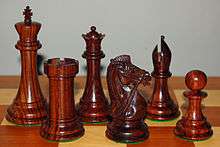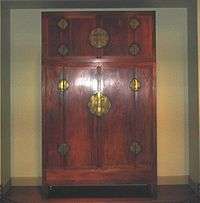Rosewood
Rosewood refers to any of a number of richly hued timbers, often brownish with darker veining, but found in many different hues.[1]
True rosewoods

All genuine rosewoods belong to the genus Dalbergia. The pre-eminent rosewood appreciated in the Western world is the wood of Dalbergia nigra. It is best known as "Brazilian rosewood", but also as "Bahia rosewood". This wood has a strong, sweet smell, which persists for many years, explaining the name rosewood.[2]
Another classic rosewood comes from Dalbergia latifolia known as (East) Indian rosewood or sonokeling (Indonesia). It is native to India and is also grown in plantations elsewhere in Pakistan (Chiniot).
Madagascar rosewood (Dalbergia maritima), known as bois de rose, is highly prized for its red color. It is overexploited in the wild, despite a 2010 moratorium on trade and illegal logging, which continues on a large scale.[3]
Throughout southeast Asia, Dalbergia oliveri is harvested for use in woodworking. It has a very fragrant and dense grain near the core, but the outer sapwood is soft and porous. Dalbergia cultrata,[4] variegated burgundy to light brown in color, is a blackwood timber sold as Burmese rosewood. Products built with rosewood-based engineered woods are sold as Malaysian rosewood or as D. oliveri.
Some rosewood comes from Dalbergia retusa, also known as the Nicaraguan rosewood or as cocobolo. Several species are known as Guatemalan rosewood or Panama rosewood: D. tucerencis, D. tucarensis, and D. cubiquitzensis.[5][6] Honduran rosewood:D. stevensonii is used for marimba keys, guitar parts, clarinets and other musical and ornamental applications.[7]
Not all species in the large genus Dalbergia yield rosewoods; only about a dozen species do. The woods of some other species in the genus Dalbergia are notable—even famous—woods in their own right: African blackwood, cocobolo, kingwood, and Brazilian tulipwood.
Some species become canopy trees (up to 30 m high), and large pieces can occasionally be found in the trade.
Other
The timber trade sells many timbers under the name rosewood (usually with an adjective) due to some (outward) similarities. A fair number of these timbers come from other legume genera; one such species that is often mentioned is Bolivian Machaerium scleroxylon sold as Bolivian rosewood. Another that may be found in market from Southeast Asia is Pterocarpus indicus, sold as New Guinea rosewood (and related species). Dalbergia sissoo is timber from rosewood species from India and Bangladesh, usually known as sheesham or North-Indian rosewood. It is extremely dense and has mild rot resistance, but it is porous and its exterior is soft and susceptible to wood-boring insects. It is used for making cabinets and flooring, and for carving. It is exported as quality veneers. Due to its after-work quality when sealed and dyed, it is often sold as genuine rosewood or as teak. It has no discernible qualities of a genuine rosewood. It has comparable strength with teak, but lower quality and price than teak or Dalbergia latifolia.
Although its wood bears no resemblance whatsoever to the true rosewoods, the Australian rose mahogany (Dysoxylum fraserianum, family Meliaceae) and Australian blackwood, (Acacia melanoxylon) are also sold as rosewood. Australian rose mahogany due to the strong smell of roses from freshly cut bark is more mistakenly called as a "rosewood".[8]
Uses

All rosewoods are strong and heavy, taking an excellent polish, being suitable for guitars (the fretboards on electric and acoustic guitars often being made of rosewood), marimbas, recorders, turnery (billiard cues, fountain pens, black pieces in chess sets, etc.), handles, furniture, and luxury flooring, etc.
Rosewood oil, used in perfume, is extracted from the wood of Aniba rosaeodora, which is not related to the rosewoods used for lumber.
Toxicity
The dust created from sanding rosewood is known to be a sensitizing irritant and can trigger asthma and other respiratory ailments. Continual or heightened exposure can increase sensitivity.[9]
Status as an endangered species
In general, world stocks are poor through overexploitation. Rosewood is now protected worldwide. At a summit of the international wildlife trade in South Africa, the Convention on International Trade in Endangered Species of Wild Fauna and Flora (CITES) moved to protect the world’s most trafficked wild product by placing all 300 species of the rosewood tree under trade restrictions. At CITES meetings in 2013, 2016, and 2019, additional rosewood species were listed for protection, triggering market booms in China.[10][11]
Characteristics

- Presence of hints of coarse grains with the shiny and silky smooth texture, compared to the glossy finish of artificial polishes
- Even texture with an orange/yellow-red to deep purple with black bars color range: Even if artificial dyes can reproduce the color, if with an uneven texture it can be confirmed the product is not made of rosewood. Fake rosewoods products have a thick color or light colors with white color in some space.
- If directly bought from workshop, the sawdust has a flowery aroma. If not, the product is compromised. Certain showpieces might have an unusual aroma; this is the effect of fragrant aerosol, not the quality.
- A drop of water mixed with sawdust makes the dust submerged and the droplet has a purplish precipitation.
- A gentle knock on the wood produces a crisp sound without noise.
List of rosewoods
From Dalbergia species
- Amazone Rosewood, Para Rosewood (Dalbergia spruceana)
- Bahia Rosewood, (Brazilian) Tulipwood, Pau Rosa, Pinkwood, Bois de rose (Dalbergia decipularis), (Dalbergia frutescens)
- Black Rosewood, Nicaraguan, Mexican or Panama and Central American Rosewood (Dalbergia retusa)
- Brazilian Rosewood, also Bahia or Rio Rosewood, Jacaranda, White Rosewood (Dalbergia nigra), german Rio-Palisander
- Brown’s Indian rosewood (Dalbergia brownei)
- Burmese Rosewood (Dalbergia oliveri) Chingchan also as Asian or Laos Rosewood, (Dalbergia bariensis), (Dalbergia cultrata, Dalbergia dongnaiensis, Dalbergia fusca)
- Chinese Rosewood, Fragrant Rosewood, Huanghuali (Dalbergia odorifera) also as Bangkok Rosewood
- Closeflower Rosewood, Camotillo (Dalbergia congestiflora)
- Granadillo Rosewood (Dalbergia granadillo)
- Grenadill(a), Bombay Rosewood, African Blackwood (Dalbergia melanoxylon)
- Guatemala oder Honduras Rosewood (Dalbergia cubilquitzensis)
- Honduran Rosewood (Dalbergia stevensonii)
- Laos Rosewood, Burmese Rosewood, Burmese Blackwood (Dalbergia cultrata)
- Laotian Rosewood (Dalbergia lanceolaria)
- Madagascar Rosewood (Dalbergia baronii, Dalbergia greveana) also as French Rosewood, and Bois de Rose (Dalbergia maritima, Dalbergia louvelii), (Dalbergia madagascariensis, Dalbergia monticola, Dalbergia trichocarpa etc.), for all Dalbergia-species from the population of Madagascar.
- Mexican Rosewood, Palo Escrito (Dalbergia paloescrito)
- (East) Indian Rosewood, Indonesian or Malabar, Bombay, Rosetta und Black Rosewood or Sonokeling Rosewood (Dalbergia latifolia)
- (North, East) Indian Rosewood, Sissoo, Sheesham (Dalbergia sissoo)
- Siamese, Siam Rosewood, Thailand Rosewood, Reclaimed Thai Rosewood (Dalbergia cochinchinensis)
- Yucatan Rosewood, Guatemalan Rosewood (Dalbergia tucurensis)
Other than Dalbergia species
- African Rosewood, False Rosewood (Guibourtia demeusei), (Guibourtia pellegriniana) and (Guibourtia tessmannii) (Bubinga), and (Guibourtia coleosperma) Rhodesian Copalwood, also (Pterocarpus erinaceus, Pterocarpus angolensis) also as West African Rosewood or Senegal, Gaboon Rosewood, Millettia laurentii (Wenge), Hagenia abyssinica also as East African Rosewood
- Andaman rosewood, redwood, padauk (Pterocarpus dalbergioides)
- Australian Rosewood Acacia spp.; (Acacia excelsa, Acacia acuminata, Acacia rhodoxylon also as Inland Rosewood, Acacia binervia) and others like (Acacia spania) also as Western Rosewood, (Acacia melanoxylon) also as Australian Blackwood etc.
- Bastard Rosewood, Australian Rosewood (Synoum glandulosum) also as Scentless Rosewood, (Knightia excelsa)
- Bolivian Rosewood, Santos Rosewood, Pau Ferro, Morado, Machaerium spp.; (Machaerium scleroxylon), (Machaerium acutifolium), (Machaerium villosum)
- Brazilian Rosewood (Dicypellium caryophyllaceum), (Physocalymma scaberrimum) also as Amazone Rosewood
- (Brazilian) Rosewood, Cayenne Rosewood, Pau Rosa, Bois de rose (femelle) (Aniba rosaeodora), (Aniba parviflora) and others (rosewood oil)
- Burmese Rosewood (Pterocarpus macrocarpus), (Pterocarpus indicus) also as New Guinea Rosewood or Andaman Rosewood, Narra
- Canary Rosewood (Genista canariensis), (Convolvulus scoparius)
- Caribbean Rosewood (Metopium brownei)
- Cayenne Rosewood, Bois de rose mâle (Ocotea cernua) or possible to other sources (Endlicheria canescens, Licaria cannella, Tetragastris altissima)
- False oder Bastard Rosewood; others than Swartzia spp.; (Dysoxylum rufum) also as Hairy Rosewood, (Jacaranda mimosifolia ), (Thespesia populnea, Thespesia populneoides) also as Pacific and Tahitian Rosewood or Polynesian Rosewood, Macawood, Granadillo (Platymiscium spp.)
- Guyana Rosewood, Bastard Rosewood (Swartzia benthamiana, Swartzia leiocalycina), (Swartzia cubensis) also as Northern Rosewood and for (Licaria guianensis) also French Rosewood
- Jamaica Rosewood (Erithalis fruticosa)
- Japanese Rosewood (Myrospermum erythroxylum)
- Mexican Rosewood, Dominican, Mayan Rosewood, Bocote; Barcino (Cordia elaeagnoides), Bojon (Cordia gerascanthus), Freijo (Cordia alliodora), Louro Preto (Cordia megalantha), Ziricote (Cordia dodecandra)
- Patagonian Rosewood (Anadenanthera colubrina)
- Tiete Rosewood (Guibourtia hymenaeifolia), (Guibourtia chodatiana)
- Rhodesian Rosewood (Guibourtia coleosperma) see African Rosewood
- West Indian Rosewood, Jamaica Rosewood, White Rosewood (Amyris balsamifera); also as Lignum rhodium
- Rosewood, Australian Rose Mahogany, Bastard Rosewood (Dysoxylum fraserianum)
- Western Rosewood, Inland Rosewood (Alectryon oleifolius)
- White Rosewood (Chionanthus ligustrinus), (Anthocarapa nitidula)
- (Pau Ferro, Pau Rosa), rosewood substitute, (Machaerium firmum), (Bobgunnia fistuloides), (Bobgunnia madagascariensis), (Berchemia zeyheri)
- Only because of scent; Rosewood oil, Oleum Ligni Rhodii, (Convolvulus floridus und Convolvulus scoparius); also as Lignum rhodium, Lignum cyprinum
- Other rosewoods; Colliguaja odorifera, Erythroxylum havanense
References
- "rosewood tree - Memidex dictionary/thesaurus". www.memidex.com. Retrieved 2016-04-02.
- "Distinguishing Brazilian Rosewood, East Indian and Other Rosewoods - The Wood Database". www.wood-database.com.
- "In search of Madagascar's rosewood mafia". BBC. 20 February 2014. Retrieved 21 February 2014.
- "Dalbergia cultrata Benth. — The Plant List". www.theplantlist.org.
- "Panama Rosewood Sets". Garnut Guitars.
- "TAXA Wood Knowledge Base".
- "Honduran Rosewood | The Wood Database - Lumber Identification (Hardwoods)". www.wood-database.com. Retrieved 2016-10-19.
- Boland, D.J.; et al. (1984). Forest Trees of Australia (Fourth ed.). CSIRO Australia. p. 120.
- "Wood Allergies and Toxicity". Eric Meier. January 2009. Retrieved 28 June 2012.
- Zhu, Annah. 2020. "Restricting trade in endangered species can backfire, triggering market booms." The Conversation. Available at: https://theconversation.com/restricting-trade-in-endangered-species-can-backfire-triggering-market-booms-124869
- Zhu, Annah. 2020. "China’s Rosewood Boom: A Cultural Fix to Capital Overaccumulation." Annals of the American Association of Geographers. Available at: https://doi.org/10.1080/24694452.2019.1613955